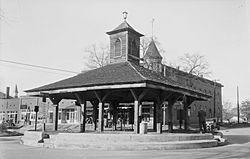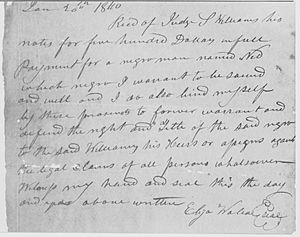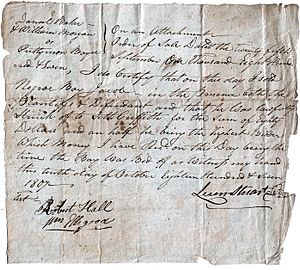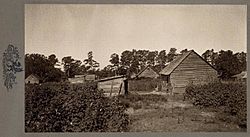Treatment of slaves in the United States facts for kids
The treatment of slaves in the United States often included abuse, the denial of education, and punishments like whippings. Families were often split up by the sale of one or more members, usually never to see or hear of each other again.
Contents
The debate over slave treatment
In the decades before the American Civil War, defenders of slavery often argued that slavery was a positive good, both for the enslavers and the enslaved people. They defended the legal enslavement of people for their labor as a benevolent, paternalistic institution with social and economic benefits, an important bulwark of civilization, and a divine institution similar or superior to the free labor in the North.
Some slavery advocates asserted that many slaves were content with their situation. African-American abolitionist J. Sella Martin countered that apparent "contentment" was in fact a psychological defense to the dehumanizing brutality of having to bear witness to their spouses being sold at auction.
After the Civil War and emancipation, White Southerners developed the pseudohistorical Lost Cause mythology in order to justify White supremacy and segregation. This mythology deeply influenced the mindset of White Southerners, influencing textbooks well into the 1970s. One of its tenets was the myth of the faithful slave. In reality, the enslaved people "desperately sought freedom". While 180,000 African-American soldiers fought in the United States Army during the Civil War, no slave fought as a soldier for the Confederacy.
Legal regulations
Legal regulations of slavery were called slave codes. In the territories and states established after the United States became independent, these slave codes were designed by the politically dominant planter class in order to make "the region safe for slavery".
In North Carolina, slaves were entitled to be clothed and fed, and murder of a slave was punishable. But slaves could not give testimony against whites nor could they initiate legal actions.
Living conditions
Compiling a variety of historical sources, historian Kenneth M. Stampp identified in his classic work The Peculiar Institution reoccurring themes in slavemasters’ efforts to produce the "ideal slave":
- Maintain strict discipline and unconditional submission.
- Create a sense of personal inferiority, so that slaves "know their place."
- Instill fear.
- Teach servants to take interest in their master's enterprise.
- Prevent access to education and recreation, to ensure that slaves remain uneducated, helpless, and dependent.
Education and access to information
Slave owners greatly feared slave rebellions. Most of them sought to minimize slaves' exposure to the outside world to reduce the risk. The desired result was to eliminate slaves' dreams and aspirations, restrict access to information about escaped slaves and rebellions, and stifle their mental faculties.
Teaching slaves to read was discouraged or (depending upon the state) prohibited, so as to hinder aspirations for escape or rebellion. Slaveowners believed slaves with knowledge would become morose, if not insolent and "uppity". They might learn of the Underground Railroad: that escape was possible, that many would help, and that there were sizeable communities of formerly enslaved Blacks in Northern cities. In response to slave rebellions such as the Haitian Revolution, the 1811 German Coast Uprising, a failed uprising in 1822 organized by Denmark Vesey, and Nat Turner's slave rebellion in 1831, some states prohibited slaves from holding religious gatherings, or any other kind of gathering, without a white person present, for fear that such meetings could facilitate communication and lead to rebellion and escapes.
In 1841, Virginia punished violations of this law by 20 lashes to the slave and a $100 fine to the teacher, and North Carolina by 39 lashes to the slave and a $250 fine to the teacher. In Kentucky, education of slaves was legal but almost nonexistent. Some Missouri slaveholders educated their slaves or permitted them to do so themselves.
Medical treatment
The quality of medical care to slaves is uncertain; some historians conclude that because slaveholders wished to preserve the value of their slaves, they received the same care as whites did. Others conclude that medical care was poor. A majority of plantation owners and doctors balanced a plantation need to coerce as much labor as possible from a slave without causing death, infertility, or a reduction in productivity; the effort by planters and doctors to provide sufficient living resources that enabled their slaves to remain productive and bear many children; the impact of diseases and injury on the social stability of slave communities; the extent to which illness and mortality of sub-populations in slave society reflected their different environmental exposures and living circumstances rather than their alleged racial characteristics. Slaves may have also provided adequate medical care to each other.
According to Michael W. Byrd, a dual system of medical care provided poorer care for slaves throughout the South, and slaves were excluded from proper, formal medical training. This meant that slaves were mainly responsible for their own care, a "health subsystem" that persisted long after slavery was abolished.
Medical care was usually provided by fellow slaves or by slaveholders and their families, and only rarely by physicians. Care for sick household members was mostly provided by women. Some slaves possessed medical skills, such as knowledge of herbal remedies and midwifery and often treated both slaves and non-slaves. Covey suggests that because slaveholders offered poor treatment, slaves relied on African remedies and adapted them to North American plants. Other examples of improvised health care methods included folk healers, grandmother midwives, and social networks such as churches, and, for pregnant slaves, female networks. Slave-owners would sometimes also seek healing from such methods in times of ill health.
Researchers performed medical experiments on slaves, who could not refuse, if their owners permitted it. They frequently displayed slaves to illustrate medical conditions. Southern medical schools advertised the ready supply of corpses of the enslaved, for dissection in anatomy classes, as an incentive to enroll.
Separation of families

Elizabeth Keckley, who grew up enslaved in Virginia and later became Mary Todd Lincoln's personal modiste, gave an account of how she had witnessed Little Joe, the son of the cook, being sold to pay his enslaver's bad debt:
Joe’s mother was ordered to dress him in his best Sunday clothes and send him to the house, where he was sold, like the hogs, at so much per pound. When her son started for Petersburgh, ... she pleaded piteously that her boy not be taken from her; but master quieted her by telling that he was going to town with the wagon, and would be back in the morning. Morning came, but little Joe did not return to his mother. Morning after morning passed, and the mother went down to the grave without ever seeing her child again. One day she was whipped for grieving for her lost boy.... Burwell never liked to see his slaves wear a sorrowful face, and those who offended in this way were always punished. Alas! the sunny face of the slave is not always an indication of sunshine in the heart.
Between 1790 and 1860, about one million enslaved people were forcefully moved from the states on the Atlantic seabord to the interior in a Second Middle Passage. This normally involved the separation of children from their parents and of husbands from their wives.
Slave breeding
Slave breeding was the attempt by a slave-owner to influence the reproduction of his slaves for profit. It included forced relations between male and female slaves, encouraging slave pregnancies to boost slave numbers.
For instance, Frederick Douglass (who grew up as a slave in Maryland) reported the systematic separation of slave families. With the development of cotton plantations in the Deep South, planters in the Upper South frequently broke up families to sell "surplus" male slaves to other markets.

Mixed-race children
By the turn of the 19th century many mixed-race families in Virginia dated to Colonial times; white women (generally indentured servants) had unions with slave and free African-descended men. Because of the mother's status, those children were born free and often married other free people of color.
Given the generations of interaction, an increasing number of slaves in the United States during the 19th century were of mixed race. With each generation, the number of mixed-race slaves increased. The 1850, census identified 245,000 slaves as mixed-race (called "mulatto" at the time); by 1860, there were 411,000 slaves classified as mixed-race out of a total slave population of 3,900,000.
Notable examples of mostly-white children born into slavery were the children of Sally Hemings, who it has been speculated are the children of Thomas Jefferson. Since 2000 historians have widely accepted Jefferson's paternity, the change in scholarship has been reflected in exhibits at Monticello and in recent books about Jefferson and his era. Some historians, however, continue to disagree with this conclusion.
Speculation exists on the reasons George Washington freed his slaves in his will. One theory posits that the slaves included two half-sisters of his wife, Martha Custis. Those mixed-race slaves were born to slave women owned by Martha's father, and were regarded within the family as having been sired by him. Washington became the owner of Martha Custis's slaves under Virginia law when he married her and faced the ethical conundrum of owning his wife's sisters.
Planters with mixed-race children sometimes arranged for their education (occasionally in northern schools) or apprenticeship in skilled trades and crafts. Others settled property on them, or otherwise passed on social capital by freeing the children and their mothers. While fewer in number than in the Upper South, free blacks in the Deep South were often mixed-race children of wealthy planters and sometimes benefited from transfers of property and social capital. Wilberforce University, founded by Methodist and African Methodist Episcopal (AME) representatives in Ohio in 1856, for the education of African-American youth, was during its early history largely supported by wealthy southern planters who paid for the education of their mixed-race children. When the American Civil War broke out, the majority of the school's 200 students were of mixed race and from such wealthy Southern families. The college closed for several years before the AME Church bought and operated it.
Summaries by survivors of slavery
Historian Ty Seidule uses a quote from Frederick Douglass's autobiography My Bondage and My Freedom to describe the experience of the average male slave as being "robbed of wife, of children, of his hard earnings, of home, of friends, of society, of knowledge, and of all that makes his life desirable."
A quote from a letter by Isabella Gibbons, who had been enslaved by professors at the University of Virginia, is now engraved on the university's Memorial to Enslaved Laborers:
Can we forget the crack of the whip, the cowhide, whipping-post, the auction-block, the spaniels, the iron collar, the negro-trader tearing the young child from its mother’s breast as a whelp from the lioness? Have we forgotten that by those horrible cruelties, hundreds of our race have been killed? No, we have not, nor ever will.



